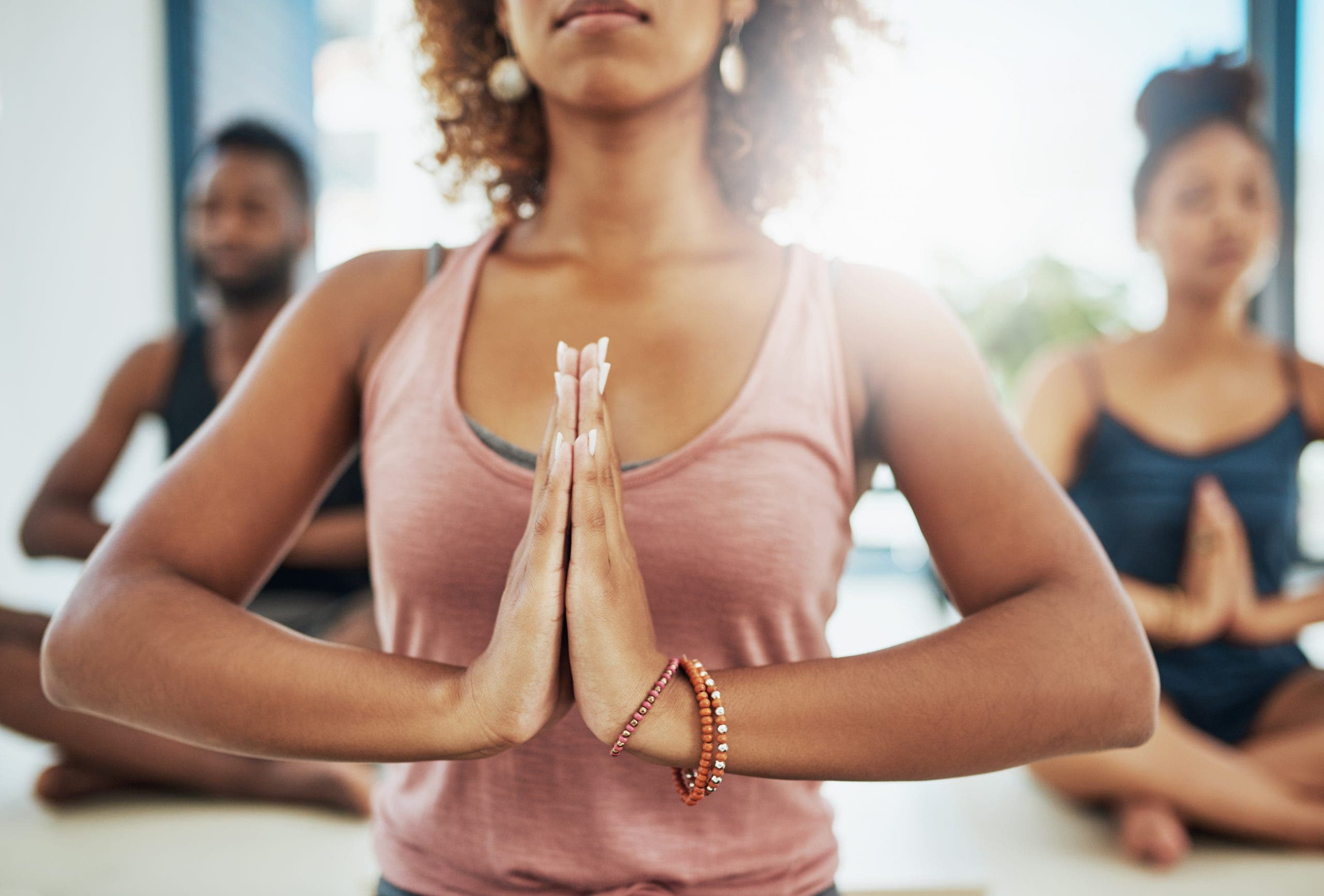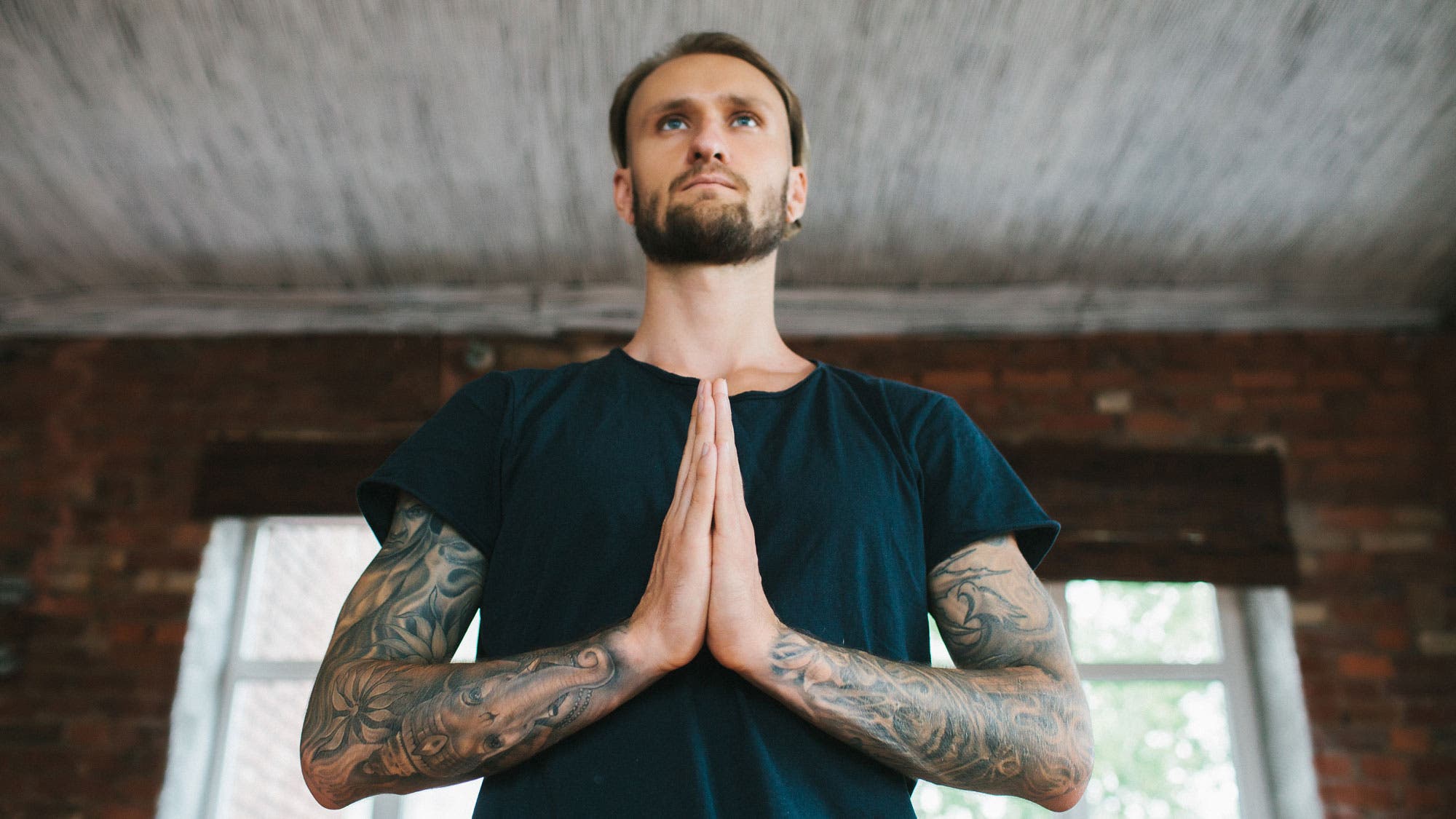If you buy through our links, we may earn an affiliate commission. This supports our mission to get more people active and outside.Learn about Outside Online's affiliate link policy
The Meaning of Namaste

(Photo: Srdjan Pav | Getty Images)
It’s the end of a typical yoga class. The teacher sits cross-legged, takes their hands in a prayer position, and reverently intones “namaste.” Dutiful students whisper namaste in unison in return without understanding the meaning of namaste. It’s so common that class may not seem complete without this ritual.
But recently, yoga practitioners have been looking more carefully at how, when, and why they’re using the word and asking questions. Do we actually understand the meaning of namaste? Are we using it properly? Should we use it at all?
Many are concerned that the term, which holds cultural significance in South Asia, has been so misunderstood and misused that it has lost its true meaning—and thus its significance.
What is the Meaning of Namaste?
Ask anyone who practices yoga for the meaning of namaste and the common response will be, “The divine in me honors the divine in you.” It’s a lovely sentiment that has been replicated everywhere on social media. But is it accurate?
“Nama means ‘bow’; as means ‘I’; and te means ‘you,’” says yoga teacher Aadil Palkhivala. “Therefore, namaste literally means ‘bow me you’ or ‘I bow to you.’”
The “divine in you” interpretation comes from the Hindu belief that divinity resides within everyone, so any person you encounter deserves respect. “The gesture is an acknowledgment of the soul in one by the soul in another,” says Palkhivala, who began studying under B.K.S. Iyengar when he was a child.
How is Namaste Pronounced?
American English speakers tend to attribute a shorter sound to the vowels and place the emphasis on the last syllable, as in nah-mah-STAY. But the term is more correctly pronounced nuh-MUH-stheh, according to yoga teacher Rina Deshpande. The two instances of the letter a are each pronounce with a short “u” sound.
The last syllable starts with a sound that will be familiar to speakers from South Asia but may take some practice for native English speakers. The “st” in namaste is a little softer than the English pronunciation, Deshpande says. Rather than a hard “t” sound, she describes it as a “th.” The tongue touches behind the front teeth to create what might be described as a clipped lisp.
If you want to practice the correct pronunciation, listen to Deshpande in the video above. Although as long as you attempt to pronounce the Sanskrit term as best you can, you shouldn’t feel uncomfortable saying it, says Desphande and Palkhivala.
When Is It Appropriate to Say Namaste
Using namaste at the end of a yoga class is, at the very least, puzzling to some South Asians.
“In my personal experience living in India and with my elders and family here in the U.S., Namaste or Namaskar is said when I meet and greet an elder. Not when I leave,” writes Susanna Barkataki, author of Embrace Yoga’s Roots: Courageous Ways to Deepen Your Yoga Practice.
“It’s rather formal,” she says. In South Asian culture, it’s most often used as a greeting of deep respect, reserved for elders, teachers, or other honorables. In this way, there’s a bit of hierarchy attached: A young person is more likely to use it to greet an elder; a student would address a teacher this way.

Although like much of yoga, the usage of namaste may be evolving. In India, you are as likely to hear it as you enter a shop or restaurant as you are to hear it in a yoga studio. That may be as a result of the term coming back to the East through eager Western tourists.
Writer Deepak Singh describes a visit to a holy Hindu town in Rajasthan, which receives many tourists seeking a spiritual awakening. “When I got there, I noticed locals…striking the pose and saying ‘namaste’ to every tourist who passed by. The smile, tone, and style of namaste were exactly like that of the teacher in my yoga class in the United States.”
While she stops short of saying that namaste has no place in yoga class, Barkataki suggests that if it is used, it’s best relied on as a considerate greeting, not a pseudo-spiritual way to signal “class is over, y’all can go.”
She suggests becoming curious and asking yourself why you’re using the term. Are you using namaste as yoga lingo to create a certain vibe in your studio,” Barkataki says. “Or as a heartfelt greeting?” Is it to signal your position as a spiritual teacher? Are you glamorizing or exoticizing the term? Has it become just a mindless habit? Be intentional and respectful in its use.
Usage of namaste that is unquestionably inappropriate is pun or play on words. “Nama’stay in bed” and “Namaslay” are an offensive misuse of a term that is considered to be respectful and spiritually resonant. Barkataki discusses this further in the below video:
What’s the Difference Between Namaste and Namaskar?
Namaste and namaskar are considered largely interchangeable when honoring someone. The term namaskar tends to be used to address people who are quite powerful, spiritually significant, and highly respected. Consider that when you do a sun salutation—Surya Namaskar—in which you are respectfully greeting the Sun.
What is the Namaste Gesture?

The gesture associated with namaste is called Anjali Mudra and pronounced UHN-jah-lee MOO-dra. Anjali evolved from the Sanskrit word “anj,” which means to honor or celebrate. Mudra means gesture. Traditionally, sacred hand movements that are used in yoga and meditation to deepen the practice.
“The simplest form of yoga is to put your hands together in namaskar,” says spiritual leader and Isha Foundation leader Sadhguru.
To engage in anjali mudra, the physical expression of namaste, press your palms together, fingers touching and pointed upward, with your thumbs at your sternum. Close your eyes and bow your head or bend at the waist.
Alternately, Palkhivala says, “It can also be done by placing the hands together in front of the third eye, bowing the head, and then bringing the hands down to the heart.” The connection with the heart points back to the belief that there is a divine spark within each of us that is located in the heart chakra, he says.
“We bring the hands together at the heart chakra to increase the flow of divine love. Bowing the head and closing the eyes helps the mind surrender to the Divine in the heart,” he says.
“If you use anjali mudra and bow, you don’t necessarily have to say the word namaste,” explains Palkhivala. “In India, it is understood that the gesture itself signifies namaste, and therefore, it is unnecessary to say the word while bowing.”
Other Expressions of Namaste
The gesture doesn’t have to be directed toward another being. You can express namaste to yourself as a form of personal meditation.
“Namaskar brings harmony between two polarities within,” says Sadhguru. It levels out any internal sense of duality.
It is also an effective way to enhance your connecting with others. He says that bringing your palms together and turn your loving attention to a person or situation you are honoring, brings almost instantaneous results. “In three to five minutes you will begin to harmonize. Namaskar into peace. Namaskar yourself into love. Namaskar yourself into union,” he says.
See also: 40 Common Sanskrit Words Every Yogi Should Know
How to use namaste in your yoga practice

Barkataki is careful not to tell people they can or cannot use the term, but suggests everyone be thoughtful when they evoke namaste. She and other South Asian yogis encourage people to educate themselves about this and any Sanskrit terms, and acknowledge that the term has a deeper meaning in Indian culture.
If the word and gesture are used in yoga settings, Palkhivala says it may be done both at the beginning and at the end of class. The first will be a greeting of respect. “At the end of class, the mind is less active and the energy in the room is more peaceful,” he says. “The teacher initiates Namaste as a symbol of gratitude and respect toward her students and her own teachers, and in return invites the students to connect with their lineage, thereby allowing the truth to flow—the truth that we are all one when we live from the heart.”
For a teacher and student, namaste allows two individuals to come together energetically,” Palkhivala says. “If it is done with deep feeling in the heart and with the mind surrendered, a deep union of spirits can blossom.”
RELATED: The Art of the Silent Bow
ABOUT OUR EXPERTS
Susanna Barkataki, M.Ed., E-RYT-500, C-IAYTI, is an Indian yoga practitioner in the Hatha yoga tradition. She is the founder of the Ignite Yoga and Wellness Institute; leader of Embody Yoga Trainings; and a diversity, accessibility, equity, and inclusion educator. She is the author of Embrace Yoga’s Roots: Courageous Ways to Deepen Your Yoga Practice.
Rina Deshpande, Ed.M., RYT-500, grew up with yoga philosophy shared by her parents in Florida, and was inspired to reconnect with her own roots in India after she became a New York City public school teacher in 2004. She is a teacher, illustrator, and poet as well as a researcher designing yoga-based interventions for scientific research at Harvard Medical School. Rina teaches yoga in New York City.
Aadil Palkhivala began studying yoga with B.K.S. Iyengar when he was seven and was introduced to Sri Aurobindo’s yoga three years later, eventually becoming an advanced Iyengar teacher. He is the founder-director of the Alive and Shine Center in Bellevue, Washington and The College of Purna Yoga. He is the author of Fire of Love for Students of Life for Teachers of Yoga and co-author of yoga manuals with his wife Savitri.
See also: Yoga for Beginners: The Ultimate Guide to Starting Your Practice